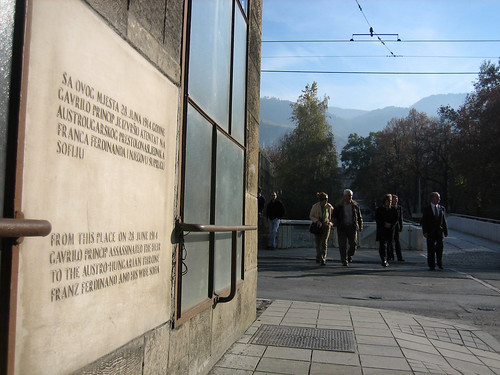Sarajevo through History, from East to West

Where the Great War began... The plaque oddly commemorates the spot from where the assassin fired the fatal shot at Archduke Franz Ferdinand. He actually died on the bridge seen in the background.
If you walk from east to west through Sarajevo, you will travel through almost six centuries of history.
In the east are the beautiful cobblestone streets of Stari Grad ("Old Town"), where in 1461 the first Ottoman governor of Bosnia turned a small village cluster into a city and state capital. Stari Grad is the fount of both tourism and Muslim culture in Sarajevo, with its ancient mosques, Turkish restaurants, sheesha bars and rows of merchants selling gleaming metal wares. It is also the favourite hangout for pigeons and the headscarved women who feed them.
Walk only a few blocks west and you will come upon the huge Old Cathedral, historical landmark and favourite meeting spot for scantily clad clubbers gathering for a night out. Standing here, one can experience being at the exact point Where East meets West, the moniker by which Sarajevo is known in just about every travel guide. The Cathedral heralds the crumbling of the Ottoman Empire and the reconquest of Eastern Europe by Christianity, beginning in 1683 when the Ottoman hordes were repelled at the gates of Vienna. Here cobblestone turns to asphalt, the old stone structures of Stari Grad are replaced by concrete and brick houses, and the rooves go from dark wood to the orange pottery tiles that are characteristic of Bosnia.
Go a bit south of here and first you will pass my apartment building, but more importantly after that the spot where Serb nationalist Gavrilo Princip fired the shot heard round the world that killed the Archduke Franz Ferdinand and his pregnant wife, prompting World War I (pictured above).
If you keep walking west, and imagine Sarajevo enduring the long war of 1914-1945, all of a sudden you will find yourself in Tito's dreary communist Yugoslavia. Tito came to power in the chaos of 1945 and ruled the region until his death in 1980. His legacy in Sarajevo consists of the occasional monument and portrait, but more visibly the ghastly, enormous concrete apartment blocks and industrial complexes which are the hallmark of post-Soviet states. The western part of Sarajevo is a sort of graveyard of creativity -- the contrast with the east could not be more stark.
But my bloated historical metaphor does not end here, oh no! For if you keep on westward, though you will probably want to get in a taxi by now, you will first pass the old 1984 Olympic complex, a reminder of how Sarajevo went from cultural centre of the world to hellish warzone in only 8 years. After that, one comes upon the enormous monument commemorating Tito's death, which has one of every type of tree found in Yugoslavia (though they were all dead and leafless when I went). Appropriately, literally only 50 feet beyond this is the frontline of the war that erupted as a result of the power vacuum created in the wake of Tito's untimely passing. Walk even further if you wish, but tread carefully around the signed areas warning of the continuing presence of landmines.
And this, dear reader, brings us all the way to 1995. If you wish to witness history since then, you will have to look to the people of Sarajevo, for the last war this city witnessed halted all progress, and it has only been rebuilding ever since.

0 Comments:
Post a Comment
<< Home